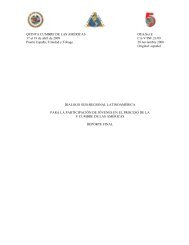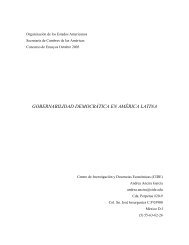The Road to Hemispheric Cooperation: Beyond the Cartagena
The Road to Hemispheric Cooperation: Beyond the Cartagena
The Road to Hemispheric Cooperation: Beyond the Cartagena
Create successful ePaper yourself
Turn your PDF publications into a flip-book with our unique Google optimized e-Paper software.
fOSTERINg A CulTuRE Of INNOvATION<br />
IN THE AMERICAS<br />
Inés Bustillo* I Direc<strong>to</strong>r, Washing<strong>to</strong>n Office of <strong>the</strong> UN Economic Commission for Latin America and <strong>the</strong> Caribbean<br />
(ECLAC)<br />
Executive Summary<br />
●● Between 2003 and 2008, <strong>the</strong> region experienced <strong>the</strong><br />
longest and strongest period of expansion since 1980,<br />
and only <strong>the</strong> second period since <strong>the</strong> late 1960s <strong>to</strong><br />
have had such high growth rates of per capita gross<br />
domestic product (GDP). <strong>The</strong> combined effects of<br />
economic growth, higher earnings, more comprehensive<br />
transfer programs, and a decline in demographic<br />
dependency rates have resulted in considerable poverty<br />
reduction.<br />
●● Despite recent growth and progress on several<br />
fronts, some exceptions notwithstanding, <strong>the</strong> region<br />
has been slow <strong>to</strong> incorporate innovation in<strong>to</strong><br />
economic activities and production chains, or value<br />
added in<strong>to</strong> exports, which are keys for streng<strong>the</strong>ning<br />
competitiveness and sustainable growth.<br />
●● Scientific and technological capabilities in Latin America<br />
and <strong>the</strong> Caribbean (LAC) are mixed, with important asymmetries<br />
and lags. For example, investment in research<br />
and development (R&D) in Latin American countries, with<br />
<strong>the</strong> exception of Brazil, is lower than expected, given <strong>the</strong><br />
level of per capita income. Most R&D in <strong>the</strong> region occurs<br />
in public labora<strong>to</strong>ries and universities, while in o<strong>the</strong>r<br />
regions it is carried out chiefly by businesses.<br />
●● Even though <strong>the</strong> price of broadband has been halved<br />
over <strong>the</strong> past two years, broadband is still expensive,<br />
slow, of poor quality and out of reach for large segments<br />
of <strong>the</strong> population.<br />
●● While <strong>the</strong> region is among <strong>the</strong> world’s most dynamic in<br />
terms of <strong>the</strong> increase in Internet users and information<br />
and communication technology (ICT) spending, this advantage<br />
has not been reflected in improved productivity.<br />
<strong>The</strong> use of ICT has had little effect on productivity because<br />
of gaps in access, poor broadband quality, and<br />
problems relating <strong>to</strong> <strong>the</strong> shortage or lack of complementary<br />
ICT assets.<br />
●● Today, science, technology and innovation occupy an important<br />
place in <strong>the</strong> agenda of several governments in <strong>the</strong><br />
region. Innovation is an increasingly integrated process<br />
that takes place over networks and requires <strong>the</strong> interaction<br />
and cooperation of various agents in both <strong>the</strong> public<br />
and private sec<strong>to</strong>rs. Streng<strong>the</strong>ning mechanisms <strong>to</strong> support<br />
regional cooperation on science, technology and innovation<br />
policies can prove key <strong>to</strong> generating synergies<br />
and complementarities.<br />
●● Aware of <strong>the</strong> need <strong>to</strong> address <strong>the</strong>se issues, both at <strong>the</strong><br />
national level and from a regional perspective, policymakers<br />
have been engaged on a number of fronts.<br />
Several initiatives in <strong>the</strong> science and technology field<br />
have been undertaken between LAC countries and <strong>the</strong><br />
United States. Such efforts should be expanded fur<strong>the</strong>r<br />
<strong>to</strong> spur innovation.<br />
<strong>The</strong> Context<br />
In <strong>the</strong> years leading up <strong>to</strong> <strong>the</strong> 2008 financial crisis, economic<br />
growth in Latin America and <strong>the</strong> Caribbean (LAC)<br />
had been at a his<strong>to</strong>ric high. Between 2003 and 2008, <strong>the</strong><br />
* Prepared by Inés Bustillo, Direc<strong>to</strong>r, Washing<strong>to</strong>n Office of <strong>the</strong> United Nations Economic Commission for Latin America and <strong>the</strong> Caribbean<br />
(ECLAC), with assistance by Fernando Flores. This paper draws on existing ECLAC research and documentation. <strong>The</strong> views expressed<br />
in this document, which has not been subject <strong>to</strong> edi<strong>to</strong>rial review by ECLAC, are solely those of <strong>the</strong> author and do not necessarily represent<br />
those of <strong>the</strong> organization.<br />
<strong>The</strong> <strong>Road</strong> <strong>to</strong> <strong>Hemispheric</strong> <strong>Cooperation</strong>: <strong>Beyond</strong> <strong>the</strong> <strong>Cartagena</strong> Summit of <strong>the</strong> Americas<br />
<strong>The</strong> Brookings Institution ❘ Latin America Initiative<br />
7








